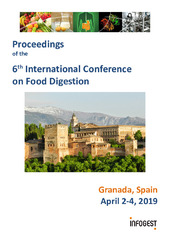Приказ основних података о документу
Digestomics of raw and roasted hazelnut according to harmonized static digestion method suitable for solid food and characterization of gastric-phase products
| dc.creator | Prodić, Ivana | |
| dc.creator | Smiljanić, Katarina | |
| dc.creator | Hoffmann-Sommergruber, Karin | |
| dc.creator | Ćirković-Veličković, Tanja | |
| dc.creator | Mihailović, Jelena | |
| dc.date.accessioned | 2022-12-26T17:30:12Z | |
| dc.date.available | 2022-12-26T17:30:12Z | |
| dc.date.issued | 2019 | |
| dc.identifier.uri | http://cherry.chem.bg.ac.rs/handle/123456789/5723 | |
| dc.description.abstract | Introduction Stability to gastric digestion represents a very important parameter of food protein allergenicity. Usu- ally digestion experiments are carried out on purified proteins or protein extracts; however, use of solid food is far closer to the in vivo situation, taking into account food protein interactions with other food components, such as polyphenols and lipids. Objective The aim of this study was to investigate and compare digestion stability and allergenicity of large and small peptides released after pepsin digestion of whole raw and roasted hazelnut kernels under standardized and physiologically relevant in vitro conditions. Methodology In vitro simulated oral and gastric phase digestion was carried out with ground raw and roasted hazelnut kernels. Digested proteins were extracted from the mixture and analyzed by SDS-PAGE, 2D-PAGE, and compared with Image Master 2D Platinum 7.0. Western blot probed with allergic patients’ sera and specific antibodies for Cor a 8. Main findings Several important hazelnut seed storage digestion resistant proteins and peptides have been identi- fied and characterized. Most abundant hazelnut allergens were resolved on a 2DE map, for instance, acidic and basic chains of Cor a 9, and Cor a 11. Digestion-resistant peptides of Cor a 11 and Cor a 9 were able to bind IgE. Lipid transfer protein (Cor a 8) was highly resistant to gastric proteolysis. Conclusion To conclude, roasted hazelnut is more prone to gastric digestion than raw, and cause milder IgE response in patients. Gastric phase digestion of raw and roasted hazelnut kernels results in partial extraction and digestion of Cor a 11 and Cor a 9 into digestion-resistant peptides with preserved IgE-binding epitopes. These results demonstrate substantial resistance of raw and roasted hazelnut allergens to gastric digestion since they remained mostly intact after 2 h of gastric (pepsin) digestion and retained their allergenicity. | sr |
| dc.language.iso | en | sr |
| dc.publisher | INFOGEST Cost action FA1402 | sr |
| dc.relation | info:eu-repo/grantAgreement/MESTD/Basic Research (BR or ON)/172024/RS// | sr |
| dc.relation | Ghent University Global Campus, Belgian Special Research Fund BOF StG No. 01N01718. | sr |
| dc.relation | Serbian Academy of Sciences and Arts Project F-26. | sr |
| dc.relation | info:eu-repo/grantAgreement/MESTD/inst-2020/200168/RS// | sr |
| dc.rights | openAccess | sr |
| dc.rights.uri | https://creativecommons.org/licenses/by/4.0/ | |
| dc.source | Proceedings of the 6th International Conference on Food Digestion 2019 | sr |
| dc.subject | Hazelnut allergens | sr |
| dc.subject | digestion | sr |
| dc.subject | food matrix | sr |
| dc.title | Digestomics of raw and roasted hazelnut according to harmonized static digestion method suitable for solid food and characterization of gastric-phase products | sr |
| dc.type | conferenceObject | sr |
| dc.rights.license | BY | sr |
| dc.citation.spage | 191 | |
| dc.citation.epage | 191 | |
| dc.type.version | publishedVersion | sr |
| dc.identifier.fulltext | http://cherry.chem.bg.ac.rs/bitstream/id/32166/bitstream_32166.pdf | |
| dc.identifier.rcub | https://hdl.handle.net/21.15107/rcub_cherry_5723 |


